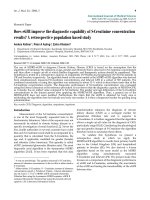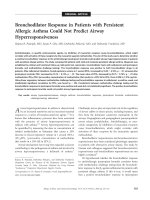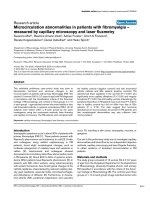Báo cáo y học: " Collaborative Care for patients with severe borderline and NOS personality disorders: A comparative multiple case study on processes and outcomes" pps
Bạn đang xem bản rút gọn của tài liệu. Xem và tải ngay bản đầy đủ của tài liệu tại đây (326.52 KB, 10 trang )
STUDY PROTO C O L Open Access
Collaborative Care for patients with severe
borderline and NOS personality disorders:
A comparative multiple case study on processes
and outcomes
Barbara Stringer
1,2*
, Berno van Meijel
2
, Bauke Koekkoek
3,4
, Ad Kerkhof
5
and Aartjan Beekman
1
Abstract
Background: Structured psychotherapy is recommended as the preferred treatment of personality disorders. A
substantial group of patients, however, has no access to these therapies or does not benefit. For those patients
who have no (longer) access to psychotherapy a Collaborative Care Prog ram (CCP) is developed. Collaborative Care
originated in somatic health care to increase shared decision making and to enhance self management skills of
chronic pa tients. Nurses have a prominent position in CCP’s as they are responsible for optimal continuity and
coordination of care. The aim of the CCP is to improve quality of life and self management skills, and reduce
destructive behaviour and other manifestations of the personality disorder.
Methods/design: Quantitative and qualitative data are combined in a comparative multiple case study. This makes it
possible to test the feasibility of the CCP, and also provides insight into the preliminary outcomes of CCP. Two
treatment conditions will be compared, one in which the CCP is provided, the other in which Care as Usual is
offered. In both conditions 16 patients will be included. The perspectives of patients, their informal carers and nurses
are integrated in this study. Data (questionnaires, documents, and interviews) will be collected among these three
groups of participants. The process of treatment and care within both research conditions is described with
qualitative research methods. Additional quantitative data provide insight in the preliminary results of the CCP
compared to CAU. With a stepped analysis plan the ‘black box ’ of the application of the program will be revealed in
order to understand which characteristics and influencing factors are indicative for positive or negative outcomes.
Discussion: The present study is, as to the best of our knowledge, the first to examine Collaborative Care for patients
with severe personality disorders receiving outpatient mental health care. With the chosen design we want to
examine how and which elements of the CC Program could contribute to a better quality of life for the patients.
Trial registration: Netherlands Trial Register (NTR): NTR2763
Background
A personality disorder is a severe and complex psychia-
tric illness. The borderline personality disorder (BPD)
and the personality disorder not otherwise specified
(NOS) both belong to the two most prevalent personal-
ity disorders. The lifetime prevalence o f borderline per-
sonality disorders is estimated at 1-2% in the general
population, whereas in patient samples the prevalence is
approximate 10-20%. The personality disorder NOS has
an estimated prevalence of 8-13% in patient samples
[1,2].
Structured psychotherapy i s recommended as the pre-
ferred treatment of personality disorders. Several studies
report modest positive t reatment results [3-9]. Psy-
chothera py contribut es to higher quality of life, reduced
psychopathology and destructive behaviour, and sustain-
able changes in personality.
* Correspondence:
1
Department of Psychiatry and EMGO institute, VU University Medical
Center/GGZ inGeest, Amsterdam, the Netherlands
Full list of author information is available at the end of the article
Stringer et al. BMC Psychiatry 2011, 11:102
/>© 2011 Stringer et al; licensee BioMed Central Ltd. This is an Open Access article d istributed under the terms of the Creativ e Commons
Attribution License (http://creati vecommons.org/licenses/by/2.0), which permits unrestricted use, distribution, and reproduction in
any medium, provided the original work is properly cited.
A substantial group of patients, however, does not
benefit from these psychotherapies [10-13]. Besides lim-
itations in availability of these therapies, some patients
do not meet the inclusion criteria or they drop ou t dur-
ing treatment. Others need more psychosocial support
for their many complex social problems. Most patients
who do not benefit have a chronic and unstable course
of illness with disruptive and destructive behaviour
[10,13,14]. They put a high demand on the health care
services provided for rather long, but often discontinu-
ous periods of time [15]. These patients often receive
community mental health care (often referred to as a
team: CMHC team), mostly provided by (community)
mental health nurses [10,14]. The treatment delivered
by CMCH teams is, however, not standardized and
highly unstructured [16,17].
Research in dicate s that especially nurses in particular
experience caring for people with severe (borderline)
personality diso rders as highly stressful [18-21]. Strong
emotional responses towards the patient arise fre-
quently, particularly when the disruptive behaviour of
the patient is unpredictable and difficult to understand.
This contributes to condemnation of the pat ient by the
nurseandalessempathicattitude. Ambivalent care
seeking of these patients, shifting between dependency
from and condemnation of professionals, can be
explained out of their disorder and the irregular course
of the therapeutic process. This same ambivalent care
seeking, however, is difficult for care providers to accept
and to cope with and it often leads to ineffective profes-
sional behaviour [22,23]. On the one hand, while balan-
cing be tween autonomy and safety of the patient, nurses
easily feel forced and responsible to protect the patient.
Nurses may apply restrictive interventions to control the
patient’ s destructive behaviour [24-26]. On the other
hand, nurses may underestimate the needs and disabil-
ities of their patients and perceive them as able but
unwilling to change [27,28]. To keep the balance
between playing a waiting game on the o ne hand, and
being overly supportive and protective on the other
hand is considered to be difficult with regard to these
patients [13,27]. Studies reveal that patients and care
providers set different priorities during treatment,
including the specific needs of patients that require
attention [29-33]. These, at times, conflicting priorities
can cause miscommunication between patients and car e
providers and, hence, adversely affect outcomes of care
[29,31].
As a response to these challenges, we developed a
structured easily accessible intervention program for this
subpopulation of patients, provided by (community)
mental health nurses. For this intervention program we
have adapted the principles of Collaborative Care (CC)
[34-36]. Collaborative Care Programs originated in
somatichealthcaretoincrease shared decision making
and to enhance self management skills of chronic
patients. Collaborative relationships come into ex istence
when patients, their informal carers, and care providers
have shared goals and mutual understanding of roles,
expectations and responsibilities. As a consequence of
more effective self management, patients report that
their quality of life improves, because they feel they can
better c ope with problems derived from their disorder
[35,36]. To date, Collaborative Care Programs (CCP)
have proven to be effective for depressive and bipolar
disorders [37-45].
Nurses have a prominent position in Collaborative
Care Programs as they function as collaborative care
managers. In this position they are responsible for opti-
mal continuity and coordinati on of care. To optimize
the c ontinuity and coordination of care, intensive part-
nership working is needed within a Collaborative Care
team (CCT). The CCT consists of the patient, his/her
informal carer, the nurse, and t he psychiatrist and/or
psychologist. The CCT can optional ly be expanded with
others who possibly could contribute to effective treat-
ment and care of the patient. The CCT lends support to
thepatientanditisinthisteamthatcrucialdecisions
regarding treatment will be made.
A Collaborative Care Program for patients with severe
personality disorder has as to the best of our knowledge
not yet been developed or tested. In this stage of inter-
vention development, insights in both the fea sibility and
as well as the preliminary results of the intervention are
needed. Therefore, we combine quantitative and qualita-
tive data in a comparative multiple case study, which
makes it possible to test the feasibility of the CCP in
clinical practice, and also provides insight into the preli-
minary outcomes of CCP [46,47]. This study functions
asaprestageforafutureRCT.Thefollowingresearch
objectives are formulated:
(1). To describe the processes of the application of a
Collaborative Care Program for patients with a
severe borderline or NOS personality disorder in
comparison with Care as Us ual (CAU) from the per-
spective of patients, their informal carers and nurses;
(2). To describe the preliminary outcomes of the
CCP in comparison with Care as Usual;
(3). To explain which characteristics of the CCP are
indicative for the occurrence of positive or negative
outcomes compared to CAU.
Methods/Design
Design
A comparative multiple case study may be used for the
thorough evaluation of complex intervention pr ograms
[46-48]. The research generates descriptive and
Stringer et al. BMC Psychiatry 2011, 11:102
/>Page 2 of 10
explanatory data regardin g treatment processes and out-
comes of the intervention program. Different perspec-
tives are integrated in the evaluation: the perspective o f
patients, their informal carers and nurses. In our multi-
ple case study two treatment con ditions will be com-
pared: one functions as the experimental condition in
which the Collaborative Care Program is provided; the
other condition functions as the control condition in
which Ca re as Usual (CAU) is offered. Different types of
data collection will be used: questionnaires, documents,
and interviews. A case is defined as the treatment pro-
cess of one patient in which integrated data from the
three perspectives (patient, informal carers and nurse)
concerning the application and the outcomes of the
CCP or CAU will be gathered and analysed.
Within a comparative multiple case study, data are ana-
lyzed at the individual case level, group level, as well as
between groups level [46-48]. The process of treatment
and care within both research conditions is described
with qualitative research methods. Additional quantita-
tive data provide insight in the preliminary results of the
CCP compared to CAU. By means of data triangulation,
the connection between the application and the prelimin-
ary outcomes of the Collaborative Care Program will be
explained in comparison with Care as Usual. With a
stepped analys is plan the ‘black box’ of the application of
the intervention program will be revealed in order to
understand which characteristics and influencing factors
are indicative for positive or negative outcomes.
Participants
Patients
Participants are recruited from two comparable commu-
nity mental health care (CMHC) teams of a large mental
health organisation in the Netherlands. One team is
indicated as the experimental condition and the other as
the control condition.
Both CMHC teams provide long-term outpa tient care
for patients with various severe mental di sorders.
Patients that will be included should be between 18 and
65 years of age, have a main diagnosis of borderline or
NOS personality disorder (DSM-IV-TR), have a score o f
15 or higher on the Borderline Personality Disorder
Severity Index (BPDSI, range 0-90) [5,49] and have
received psychiatric care for at least two years. Partici-
pants are required to spea k and read Dutc h sufficiently
well to fill in the questionnaires.
Participants are excluded when they currently partici-
pate in a structured psychotherapeutic program or when
it is expected they will participate in such a program
within a period of nine months from the start of the
study. All participants will be asked to sign for inform ed
consent based on oral and written i nformation about
the research project.
Informal carers
The participating patients will be asked to give their
permiss ion for appro aching one of th eir informal carers
to also participate in the study. The carers need to be in
contact with the patient (physically or by telephone/
email) for at least one hour a week. When the collabora-
tion with an informal ca regiver impedes the treatment
process or negatively influences the safety of the patient,
carers can be excluded. This will only take place after
consultation with the patient.
Nurses
Ten mental health nurses from the experimental condi-
tion and five nurses from the control condition will be
included in the study. Participation takes place on a
voluntary basis. Nurses who participate in the experi-
mental condition will receive a t hree-days training in
providing the Collaborative Care Program. Nurses in the
control condition will offer Care as Usual.
Selection of patients
The required number of cases for a multiple case study
depends upon the heterogeneity among the cases (more
heterogeneity requires more cases) and is therefore arbi-
trary. To take into account the variety in presentation of
the disorder and the variety of problems, this study will
include at least sixteen patients in each condition. This
adds up to 32 cases.
Intervention
Collaborative Care Program
This Collaborative Care Program is developed to
improve the quality of care for patients with severe per-
sonality disorders within a community mental health
care setting. The expectation is that the Collaborative
Care Program (1) improves qual ity of life, (2) reduces
destructive behaviour (suicidal, self harm, aggressive or
addictive behaviour) and other manifestations of the
(borderline or NOS) personality disorder, (3) improves
mastery of the patient, and (4) enhances satisfaction
with care by both patients and informal c aregivers.
Finally, we aim for a positive effect on attitudes, knowl-
edge and skills of nurses.
Collaborative Care for patients with severe borderline
or NO S personality disorders consists of five integrated
component s (see Figure 1). The different components of
the execution stage can be applied in a flexible order,
dependent on the priorities in unmet needs and the pre-
ferences of the patient. Although CCP offers a goal-
oriented structure, it comes to the professionalism of
the nurses to adjust this structure to the preferences of
the patient, the patient’s cognitive capacities, and to the
extent of illness insight/acceptance of each individual
patient. The different components of the CCP will be
briefly elucidated. The Collaborative Care Program is
Stringer et al. BMC Psychiatry 2011, 11:102
/>Page 3 of 10
elaborated in a workbook for patients and nurses and in
a separate manual for nurses. More detaile d information
about the content of t he CC Program is available (see
Additional file 1).
1. Organization and contracting A Collaborative Care
Team will be put together for adequate coordination of
care, with optimal collaboration between the main team
partners: i.e. the patient, his/her informal carer(s), a psy-
chiatric nurse and a psychiatrist and/or psychologist.
Because discontinuity of ca re increases the risk of drop-
out and a negative course of the psychiatric illness (with
possible suicide as the extreme negat ive outcome), Co l-
laborative Care demands pro-active collab oration
between all partners to minimize this discontinuity of
care. The nurse is responsible to inform and involve all
those partners, whenever necessary. The execution stage
of the CCP should not start before a treatment plan is
established to which all collaborative partners commit
[37,40,42]. Due to the ambivalent care seeking of most
of the patients, this stage is therefore crucial and
requires a careful preparation. This preparation stage
consists of several activities (see Additional File 1).
Within Collaborative Care the patient is perceived as
the one who shapes his own life, and hence his own
treatment. Active involvement of the patient is required
to reach the objectives of improved self management
skills and shared decision making [36]. Patients, how-
ever, often have a long history of contacts with health
care providers, with divergent success. To learn from
previous experiences, an inventory is made of life events
and of former treatments, based on the medical record.
This inventory will be discussed with the patient and
with the other members of the Collaborative Care Team
to identify effective coping strategies with life events,
effective elements in treatment, and relationships.
Patients are invited to express their expectations about
care providers and treatment and to speak aloud about
disappointing (sometimes even traumatic) experiences,
which still may hamper the relationships with care pro-
viders. Informal carers are invited to share their view
upon past life events and expectations with regard to
collaboration and treatment. Mutual expectations and
responsibilities are made explicit between patients,
informal carers and care providers, in order to promote
a strong relationship [26,50]. The agreements about the
collaboration are recorded in the treatment plan.
Health care needs will be assessed with the Camber-
well Assessment of Needs (CAN) [51]. Based on the
CAN results priorities in treatment goals will be set
within the Collaborative Care Team. Unmet needs, goals
and related activities are recorded in the treatment plan.
In anticipation of possible crises, a crisis card will be
compiled [26]. The use of a crisis card fits in the philo-
sophy of collaborative care because it communicates
that patients are (at least partly) able to cope with crisis
themselves. If not, a back up of professional care is
always available 24/7. The content of the crisis card is
communicated with the crisis services and informal
carers. Additionally, contracting will be used, based on
shared decision making about the collaboration, the
treatment process and the treatment plan [26,50]. The
final step in the preparation stage is to confirm t he
goals, activities and agreements about collaboration in
the treatment plans, which are evaluated every three
months.
2. Destructive behaviour To reduce destructive beha-
viours a method of early recognition and early interven -
tion will be implemented [26,52-54]. These destructive
behaviours may have different forms: suicidal, self harm,
addictive or aggressive behaviours. The central aim of
the intervention strategy is the recognition of early
warning signs (thoughts, feelings and/or behaviours) of
the destructive behaviour of the patient. The aim is to
help the patient gain a better insight in the process of
destructive behaviour and to enhance coping with this
behaviour. A relapse prevention plan will be drafted in
which ea rly signs are described, as w ell as actions how
to respond to raising stress, despair and imminent crisis.
3. Problem Solving Treatment To reduce daily life pro-
blems Problem Solving Treatment (PST) will be applied
[55]. The amount of daily life problems is often over-
whelming in this subpopulation of patients, through
which they may loose their sense of control. Learning
and applying problem solving s kills regarding daily pro-
blems enhances mastery and may result in a better qual-
ity of life. Mastery reflects the extent to which
individuals perceive themselves in control of forces that
significantly impact on their lives. PST has proven to be
effective in different studies and is part of different
treatments for personality disorders [50,55,56]. It is an
Treatment
Evaluation
2. Destructive
behaviour:
Early recognition and
early intervention
3. Problem Solving
Treatment
5. Psycho-education
Evaluation and
adjustment of the
treatment
plan every
3 months
Training, supervision, coaching and consultation for nurses
4. Life orientation
1. Organization and
‘contracting’:
a. introduction CCP
b. evaluation existing
collaboration
c. assessment of care
needs
d. crisis management
e. treatment plan
Preparation
Figure 1 the five integrated components of the Collaborative
Care program.
Stringer et al. BMC Psychiatry 2011, 11:102
/>Page 4 of 10
essential element of Collaborative Care Programs
[34,39,45].
4. Life orientation As counterb alance to th e prominent
attention to problems and destructive behaviour, the
focus of CCP is also aimed at a more positive orienta-
tion in a person’ s life. Elements of Sol ution Focused
Treatment will therefore be used to encounter and
expand po sitive experiences whic h is expected to be sti-
mulating for a renewed and more positive life orienta-
tion [57,58].
5. Psycho-education By means of psycho education, the
patient (and their carer) is provided with knowledge
about his or her psychological condition, the causes and
consequences of that condition, ways of coping with it,
and the treatment possibilities including the expected
effects of it. Patients and their carers also will be pre-
pared to the enduring character of the illness and to
expected relapses. Psycho education is an integral ele-
ment of Collaborative Care [36,39,42].
Treatment integrity
The nurses who participate in the experimental condi-
tion will receive a t hree-day training program from
three of the authors (BS, BvM en BK) in the principles
and skills of the CC Program. During the provision of
the CC Program, supervision for the nurses will be
provided for continuing education on attitude and
skills. Bi-weekly individual consultation and coaching
(by telephone or email) will be offered based on the
work sheets of the workbook and the manual to
further support treatment integrity. Supervision, con-
sultation and coaching are provided by the first author
(BS).
Control Condition
Patients in the control condition receive care as usual
from their current care providers. During the study per-
iod, nurses in both conditions are not permitted to
receive any extra training that might interfere with the
content of the CCP.
Data collection
There are three measurements in this study: when parti-
cipants enter the study (T0), after five months (T1) and
after nine months (T2). To achieve the formulated
objectivesofthisstudy,thedata collection is divided
into two parts. Quantitative data are collected with
questionn aires to describe the outcomes of t he CC Pro-
gram in comparison with the CAU (summarized in
table 1). Qualitative data, such as interviews, and records
of the supervision sessions are used to analyse the
implementation process of the application of the CCP in
comparison with CAU. D ata will be collected among
patients, their informal carers and nurses, as m entioned
below.
Questionnaires for patients
Sample characteristics
Information will be gathered at baseline on demographic
characterist ics (age, gender, educa tion level, marital sta-
tus, work and ethnicity), history of illness, current medi-
cation use and diagnostic characteristics (DSM-IV Axis
II by means of the Structured Clinical Interview for
DSM-IV Personality Disorders (SCID-II) [59], the other
axes are obtained from the medical records).
Primary outcome indicators
Quality of life The Manchester Short Appraisal
(MANSA) is a self-report scale, which measures quality
of life. It is a short version (16 items) of the Lancashire
Quality of Life Profile (LQoLP). Priebe et al. [60] found
an adequate correlation between the results on both
QoL scales.
Borderline Personality Disorder Severity Index
(BPDSI) The BPDSI is a DSM-IV BPD criteria-based
semi-structured interview consisting of 70 items. It
represents the current severity and frequency of the
DSM-IV BPD manifestations. This instrument showed
excellent psychometric features [5,49,61].
Secondary outcome and process indicators
Destructive behaviours Four frequently observed
destructive behaviours are measured. The BPDSI con-
tains subscales measuring parasuicidal behaviour, includ-
ing self harm, and aggressive behaviour. Additionally, the
Beck Scale for Suicidal Ideation is used to measure suici-
dal thoughts, ideas and behaviours. It is a self-report
scale of 21 items and has good psychometric properties
[62,63]. The CAGE questions Adapted to Include Drugs
(CAGE-AID) is a composed questionnaire describing the
consequences of alcohol and drugs use [64].
Health care use The Trimbos/iMTA questionnaire for
Costs associated with Psychiatric Illness (TiC-P) is
developed to measure health care consumption (part 1)
and c osts (part 2) [65]. In this study only part 1 of the
questionnaire, concerning health care consumption, is
used.
Psychosocial symptoms The Brief Symptom Inventory
(BSI) is a shorted version of the SCL-90 with 53 items
(self report). Reliability and validity are almost identical
to the SCL-90 [66].
Patient satisfaction For the measurement of patient
satisfaction the Consumer Quality-Index (CQ -Index) for
outpatient mental health care is used [67]. It comprises
items about information provision, involvement in treat-
ment decisions, expertise and availability of profes-
sionals, and outcomes of treatment.
Quality of the therapeutic relationship The Scale to
Asses Therapeutic Relationships in Community Mental
Health Care (STAR) is a questionnaire which measures
the quality of the therapeutic relationship [68]. A profes-
sional and patient version of the scale is available and a
Stringer et al. BMC Psychiatry 2011, 11:102
/>Page 5 of 10
Dutch translation of this questionnaire will be used in
this study.
Mastery Pearl in and Schooler ’ s Personal Mastery Scale
(PMS, 1978) is a commonly used instrument to measure
the external locus of control, also referred to as mastery.
It consists of five items on a four point Likert scale (self
report). The PMS has a dequate validity and reliability
[69,70].
Questionnaires for informal carers
Process indicators
Carer satisfaction with care For the measurement of
carer satisfaction an adapt ed ver sion of the CQ-index is
used [67].
Involvement/social support The Involvement Evalua-
tion Questionnaire ( IEQ) [71,72] is a self report list of
81 items, divided among seven sections. It measures
consequences of care giving in informal carers.
Questionnaires for nurses
Sample characteristics
Information is gathered at baseline on demographic
characteristics (age, gender, education), working experi-
ence in mental health care and with this spe cific patient
population.
Process indicators
Quality of the therapeutic relationship Complemen-
tary to the patient’s vie w on the quality of the therapeu-
tic relationship, nurses will be asked to fill in the
professional version of the STAR [68].
Attitudes towards destructive behaviours The Suicide
Behavior Attitude Questionnaire (SBAQ) consists of 21
items to be scored on visual analogue scales. Three sub-
scale are differentiated: (1) feelings in relation with the
care for suicidal patients, (2) professional skills and (3)
the right for suicide [73].
Attitudes towards self harm are measured with the
Attitudes Towards Deliberate Self-Harm Questionnaire
(ADSHQ) as developed by McAllister et al. [74].
Process forms
Nurses in both conditions fill in process forms in which
the number and content of contacts will be registered.
In the experimental group items are added which pro-
vide additional insight in the treatment integrity. The
process form follows the e lements of the intervention
and will systematically remind them on the structure
and objectives of the CC Program.
Qualitative data
Interviews
Individual interviews with patients, their carers and
nurses (in this fixed order) will take place after the fol-
low up measure ment (T2). In the in-depth interviews
the process of the application of the CC Program, and
the relation ship between this applic ation and outcomes
will be examined and compared to the applicati on of
CAU. In the interviews participants are first asked to
reflect on the quantitative outcomes and on which
changes they perceive as most beneficial. S ubsequently,
the underlying (neutrally formulated) principles of the
CCP will be discussed, e.g. problem solving, coping with
destructive behaviour, quality of the therapeutic rela-
tionship, and self-management. Next, exemplifications
will be asked to i dentify characteristics of these
Table 1 Summary of the used questionnaires
Questionnaires
Outcome
indicator
Patients Informal caregivers Nurses
Quality of Life ▪ Manchester Short Appraisal (MANSA)
Psychopathology ▪ Borderline Personality Disorder Severity Index (BPDSI)
▪ Structured Clinical Interview for DSM-IV Personality
Disorders (SCID-II)
Destructive
behaviours
▪ BPDSI
▪ Beck Scale for Suicide Ideation (BSSI)
▪ CAGE questions-adapted to include drugs (CAGE-AID)
▪ Suicide Behaviour Attitude
Questionnaire (SBAQ)
▪ Attitudes Towards Deliberate Self-
Harm Questionnaire (ADSHQ)
Health care use ▪ Trimbos/iMTA questionnaire for Costs associated with
Psychiatric Illness (Tic-P)
▪ process forms
Psychosocial
symptoms
▪ Brief Symptom Inventory (BSI)
Satisfaction ▪ Consumer Quality-index (CQ-index) ▪ CQ-index
Therapeutic
Alliance
▪ Scale to Asses Therapeutic Relationships in Community
Mental Health Care (STAR)
▪ STAR
Mastery ▪ Pearlin Mastery Scale (PMS)
Involvement/social
support
▪ Involvement Evaluation
Questionnaire (IEQ)
Stringer et al. BMC Psychiatry 2011, 11:102
/>Page 6 of 10
principles which may explain the individual outcomes.
Finally, the participants are asked to identify hampering
or fostering components in the application of CCP or
CAU.
The interviews will be audio taped and tran scribed ver-
batim. The data will be analysed using WINMAX quali-
tative text analysis software. The credibility and
dependability of the data will be ensured by peer debrief-
ing, member checking, and thick descriptions [75].
Supervision records
During the execution of the CCP nurses receive supervi-
sion. It focuses on the individual application of the CCP
and on the promoting and impeding factors regarding
the execution of CC. The supervisions will be audio
taped and transcribed verbatim. The records of these
supervisions will be examined using content analysis.
Data analysis
A distinctive feature of a comparative multiple case
study is the analysis of data on three different levels:
Firstly at individual case level, secondly at group level
and thirdly at the level of the comparison between the
two conditions. At case level the combined quantitative
and qualitative data will be used to gain insight in h ow
the application of the CCP in an individual participant
has evolved and how this is related to the outcomes.
Hence, in first instance a within case analysis of the
data fro m different data sources and different perspec-
tives will be made for each individual case. Secondly,
within the experimental and the control condition cross
case analyses will be performed to formulate statements
about the observed processes and outcomes per condi-
tion. C ases will be subdivided in three categories: (1) a
group of cases with positive outcomes; (2) a group o f
caseswithnoneorminimalchangesinoutcomesand
(3) a group of cases with negative outcomes. Within
these three subgroups patient characteristics and the
process of application will be compared to explain the
different outcomes.
Finally, at an aggregated group level the observed dif-
ferences in outcomes and process indicators will be
examined between the experimental and the control
condition (cross case synthesis) in order to assess the
value of the intervention compared to care as usual and
to explain differences in outcomes between the two
treatment conditions.
Qualitative analyses
To describe and understand the process of the applica-
tion of the CCP versus CAU, the qualitative interviews
with patients, their carers and nurses w ill be analyzed,
following the three steps as described above. Before-
hand, as preparation for the interviews, the supervision
recordswillbeanalysedandthequantitativeoutcomes
will be assessed at an individual level.
For the within case analyses, the data from the inter-
views are coded and categorized followi ng the structure
as describ ed above. As said, for the cross case analysis
the participants of both research conditions are divided
in three subgroups. Based on t he interview data, simila-
rities and differences in the process of the application
are described for the three subgroups. The different per-
spectives of pat ients, informal caregivers and nurses will
be taken into account in this analysis. The degree, to
which the se perspectives differ from each other, might
be indicative for the obtained outcomes. For the cross
case synthesis, the data from the i nterviews will be
examined to identify group differences between the two
research conditions: Which statements do participants
make about the underlying principles of the CCP? How
do they value these principles? How do they value the
outcomes of the CCP resp. CAU?
A content analysis of the supervision records will be
performed to identify hampering and fostering charac-
teristics in the process of the application of the CCP
from a nursing perspective. For the within case analysis
this information will be used as a preparation for the
interviews. When performing the cross case analysis and
synthesis, this information exemplifies and partially
explains observed outcomes of the application of CCP.
Quantitative analyses
The used questionnaires provide qu antitative dat a about
the outcome indicators from dif ferent perspectives. For
the within case analyses thequantitativedataare
assessed to describe the individual outcomes. To facili-
tate the cross case analysis, differences in characteristics
of the participants within the three subgroups are
described. Descriptive analysis of the process forms will
give additional information, which will be used for the
cross case analysis and synthesis.
Statistical analyses will be performe d to examine the
differences at group level between the experi mental and
the control condition at the different measurements
(cross case synthesis). Parametric and non-parametric
comparisons of mean scores will be used. These analyses
are used to identify preliminary results and to support
the qualitative data. These quantitative data combined
with the qualitative data provide insights in the value of
CC and in the feasibility of the intervention from differ-
ent perspectives.
Discussion
A substantial group of patients with borderline or NOS
personality disorders does, for different reasons, not par-
ticipate in evidence based psychotherapeutic programs
aimed at structural changes in personality and recovery.
Poor quality of life, severe suffering, high risk of suicidal
behavio ur, and high healt h care use (and corresponding
Stringer et al. BMC Psychiatry 2011, 11:102
/>Page 7 of 10
costs) of this population without access to these psy-
chotherapies, justify the development of a structur ed,
easy-ac cessible interv ention program. Our Collab orative
Care Program may functio n as a valuable alternative for
the relatively unstructured treatment which dominates
the care as usual within existent community mental
health care teams [16,17]. Within these CMHC teams
nurses are the main care providers, although they are
not always e quipped to meet this responsibility. Colla-
borative Care (CC) will offer them a structured method
in providing care for patients with severe perso nality
disorder.
The present study is, as to the best of our knowledge,
the first to examine Collaborative Care for patients with
severe personality disorders receiving outpatient mental
health care. Currently, health care research on the out-
comes of interventions is dominated by randomized
clinical trials. However, depending on the development
stage of interventions other designs are desirable and
available [76,77]. With the chosen design we want to
examine how and which elements of the CC Program
could contribute to a better quality of life f or the
patients and whether it will give better results for their
carers and the staff than care as usual. Based on the
results of our study, the CC Program can be adapted in
such a way that the chance for effectiveness will be
maximized in a following RCT. This comparative multi-
ple case study, hence, precedes the question of effective-
ness. The start of this study is anticipated for January
2011 with results available in April 2012.
Ethical considerations
This research project has been approved by the Medical
Ethics Committee of the VU Medical Centre in Amster-
dam, the Netherlands.
Additional material
Additional file 1: A Collaborative Care Program for patients with
severe borderline or NOS personality disorders. This additional file
elucidates the content of the Collaborative Care Program in more detail.
Acknowledgements
The study is funded by VU University Medical Center and GGZ inGeest,
Amsterdam, the Netherlands, and Inholland University for Applied Research,
Amsterdam, the Netherlands.
Author details
1
Department of Psychiatry and EMGO institute, VU University Medical
Center/GGZ inGeest, Amsterdam, the Netherlands.
2
Research Group Mental
Health Nursing, Inholland University for Applied Sciences, Amsterdam, the
Netherlands.
3
Propersona, Centre for Education and Science, ProPersona,
Wolfheze, the Netherlands.
4
Research Group Social Psychiatry & Mental
Health Nursing, HAN University of Applied Science, Nijmegen, the
Netherlands.
5
Department of Clinical Psychology and EMGO institute, VU
University Medical Center, Amsterdam, the Netherlands.
Authors’ contributions
BS is responsible for the initial draft of this article, and for the development,
organization and implementation of the study. BvM and BK have
contributed to the design and the development of the CC Program. The
supervisors AB, AK, BK and BvM have reviewed the design and the
workbook and manual of the CC Program, and revised earlier versions of the
manuscript. All authors read and approved the final manuscript.
Competing interests
The authors declare that they have no competing interests.
Received: 10 January 2011 Accepted: 24 June 2011
Published: 24 June 2011
References
1. Weissman MM: The epidemiology of personality disorders: a 1990
update. J Pers Disord 1993, , supplement: 44-62.
2. Verheul R, Widiger TA: A meta-analysis of the prevalence and usage of
the personality disorder not otherwise specified (PDNOS) diagnosis. J
Pers Disord 2004, 18:309-319.
3. Bateman A, Fonagy P: 8-year follow-up of patients treated for borderline
personality disorder: mentalization-based treatment versus treatment as
usual. Am J Psychiatry 2008, 165:631-638.
4. Binks CA, Fenton M, McCarthy L, Lee T, Adams CE, Duggan C:
Psychological therapies for people with borderline personality disorder.
Cochrane Database Syst Rev 2006, CD005652.
5. Giesen-Bloo J, Dyck van R, Spinhoven P, Tilburg van W, Dirksen C, Asselt
van T, Kremers I, Nadort M, Arntz A: Outpatient psychotherapy for
borderline personality disorder: randomized trial of schema-focused
therapy vs transference-focused psychotherapy. Arch Gen Psychiatry 2006,
63:649-658.
6. Leichsenring F, Leibing E: The effectiveness of psychodynamic therapy
and cognitive behavior therapy in the treatment of personality
disorders: a meta-analysis. Am J Psychiatry 2003, 160:1223-1232.
7. Linehan MM, Comtois KA, Murray AM, Brown MZ, Gallop RJ, Heard HL,
Korslund KE, Tutek DA, Reynolds SK, Lindenboim N: Two-year randomized
controlled trial and follow-up of dialectical behavior therapy vs therapy
by experts for suicidal behaviors and borderline personality disorder.
Arch Gen Psychiatry 2006, 63:757-766.
8. Bosch van den LM, Koeter MW, Stijnen T, Verheul R, Brink van den W:
Sustained efficacy of dialectical behaviour therapy for borderline
personality disorder. Behav Res Ther 2005, 43:1231-1241.
9. Verheul R, Bosch van den LM, Koeter MW, De Ridder MA, Stijnen T, Brink
van den W: Dialectical behaviour therapy for women with borderline
personality disorder: 12-month, randomised clinical trial in The
Netherlands. Br J Psychiatry 2003, 182:135-140.
10. Koekkoek B, Meijel van B, Hutschemaekers G: “Difficult patients” in mental
health care: a review. Psychiatr Serv 2006, 57:795-802.
11. Skodol AE, Gunderson JG, McGlashan TH, Dyck IR, Stout RL, Bender DS,
Grilo CM, Shea MT, Zanarini MC, Morey LC, Sanislow CA, Oldham LM:
Functional impairment in patients with schizotypal, borderline, avoidant,
or obsessive-compulsive personality disorder. Am J Psychiatry 2002,
159:276-283.
12. Zanarini MC, Frankenburg FR, Reich DB, Fitzmaurice G: Time to attainment
of recovery from borderline personality disorder and stability of
recovery: A 10-year prospective follow-up study. Am J Psychiatry 2010,
167:663-667.
13. Luyn B: Severe cases: management of the refractory borderline patient.
In Severe Personality Disorders. Everyday Issues in Clinical Practice. Edited by:
Luyn B, Akhtar S, Livesley WJ. Cambridge: Cambridge University Press; 2007:.
14. Paris J: Managing suicidal crises in patients with severe personality
disorders. In Severe Personality Disorders. Everyday Issues in Clinical Practice.
Edited by: Luyn B, Akhtar S, Livesley WJ. Cambridge: Cambridge University
Press; 2007:.
15. Soeteman DI, Hakkaart-Roijen van L, Verheul R, Busschbach JJ:
The
economic burden of personality disorders in mental health care. J Clin
Psychiatry 2008, 69:259-265.
16. Koekkoek B, Meijel van B, Hutschemaekers G: Community mental health
care for people with severe personality disorder: a narrative review. The
Psychiatrist 2010, 34:24-30.
Stringer et al. BMC Psychiatry 2011, 11:102
/>Page 8 of 10
17. Koekkoek B, Meijel van B, Schene A, Hutschemaekers G: Community
psychiatric nursing in the Netherlands: a survey of a thriving but
threatened profession. J Psychiatr Ment Health Nurs 2009, 16:822-828.
18. Deans C, Meocevic E: Attitudes of registered psychiatric nurses towards
patients diagnosed with borderline personality disorder. Contemp Nurse
2006, 21:43-49.
19. Fraser K, Gallop R: Nurses’ confirming/disconfirming responses to patients
diagnosed with borderline personality disorder. Arch Psychiatr Nurs 1993,
7:336-341.
20. Markham D, Trower P: The effects of the psychiatric label ‘borderline
personality disorder’ on nursing staff’s perceptions and causal
attributions for challenging behaviours. Br J Clin Psychol 2003, 42:243-256.
21. Newton-Howes G, Weaver T, Tyrer P: Attitudes of staff towards patients
with personality disorder in community mental health teams. Aust N Z J
Psychiatry 2008, 42:572-577.
22. Koekkoek B, Meijel van B, Tiemens B, Schene A, Hutschemaekers G: What
makes community psychiatric nurses label non-psychotic chronic
patients as ‘difficult’: patient, professional, treatment and social
variables. Soc Psychiatry Psychiatr Epidemiol 2010.
23. Koekkoek B, Meijel van B, Schene A, Hutschemaekers G: Development of
an intervention program to increase effective behaviours by patients
and clinicians in psychiatric services: Intervention Mapping study. BMC
Health Serv Res 2010, 10:293.
24. Hendin H, Haas AP, Maltsberger JT, Koestner B, Szanto K: Problems in
psychotherapy with suicidal patients. Am J Psychiatry 2006, 163:67-72.
25. Goldblatt MJ, Waltsberger JT: Countertransference in the treatment of
suicidal patients. In Oxford textbook of suicidology and suicide prevention. A
global perspective. Edited by: Wasserman D, Wasserman C. Oxford: University
Press; 2009:.
26. Jobes DA: Managing Suicidal Risk. A Collaborative Approach New York: The
Guilford Press; 2006.
27. Koekkoek B, Meijel van B, Schene A, Hutschemaekers G: Clinical problems
in community mental health care for patients with severe borderline
personality disorder. Community Ment Health J 2009, 45:508-516.
28. Koekkoek B, Meijel van B, Schene A, Hutschemaekers G: Problems in
psychiatric care of ‘difficult patients’: a Delphi-study. Epidemiol Psichiatr
Soc 2009, 18
:323-330.
29. Hansen T, Hatling T, Lidal E, Ruud T: The user perspective: respected or
rejected in mental health care? J Psychiatr Ment Health Nurs 2004,
11:292-297.
30. Hayward M, Slade M, Moran PA: Personality disorders and unmet needs
among psychiatric inpatients. Psychiatr Serv 2006, 57:538-543.
31. Junghan UM, Leese M, Priebe S, Slade M: Staff and patient perspectives
on unmet need and therapeutic alliance in community mental health
services. Br J Psychiatry 2007, 191:543-547.
32. Lasalvia A, Bonetto C, Tansella M, Stefani B, Ruggeri M: Does staff-patient
agreement on needs for care predict a better mental health outcome?
A 4-year follow-up in a community service. Psychol Med 2008, 38:123-133.
33. Lasalvia A, Bonetto C, Malchiodi F, Salvi G, Parabiaghi A, Tansella M,
Ruggeri M: Listening to patients’ needs to improve their subjective
quality of life. Psychol Med 2005, 35:1655-1665.
34. Bodenheimer T, Lorig K, Holman H, Grumbach K: Patient self-management
of chronic disease in primary care. JAMA 2002, 288:2469-2475.
35. Lorig KR, Holman H: Self-management education: history, definition,
outcomes, and mechanisms. Ann Behav Med 2003, 26:1-7.
36. Korff von M: Collaborative Management of Chronic Illness. Annals of
Internal Medicine 1997, 127:1097-1102.
37. Gilbody S, Bower P, Fletcher J, Richards D, Sutton AJ: Collaborative care for
depression: a cumulative meta-analysis and review of longer-term
outcomes. Arch Intern Med 2006, 166:2314-2321.
38. Orden van M, Hoffman T, Haffmans J, Spinhoven P, Hoencamp E:
Collaborative mental health care versus care as usual in a primary care
setting: a randomized controlled trial. Psychiatr Serv 2009, 60:74-79.
39. Vlasveld MC, Anema JR, Beekman AT, Mechelen van W, Hoedeman R,
Marwijk van HW, Rutten FF, Hakkaart-Roijen van L, Feltz-Cornelis van
der CM: Multidisciplinary collaborative care for depressive disorder in
the occupational health setting: design of a randomised controlled trial
and cost-effectiveness study. BMC Health Serv Res 2008, 8:99.
40. Bower P, Gilbody S, Richards D, Fletcher J, Sutton A: Collaborative care for
depression in primary care. Making sense of a complex intervention:
systematic review and meta-regression. Br J Psychiatry 2006, 189:484-493.
41. Bauer MS, McBride L, Williford WO, Glick H, Kinosian B, Altshuler L,
Beresford T, Kilbourne AM, Sajatovic M: Collaborative care for bipolar
disorder: Part II. Impact on clinical outcome, function, and costs.
Psychiatr Serv 2006, 57:937-945.
42. Bauer MS, McBride L, Williford WO, Glick H, Kinosian B, Altshuler L,
Beresford T, Kilbourne AM, Sajatovic M: Collaborative care for bipolar
disorder: part I. Intervention and implementation in a randomized
effectiveness trial. Psychiatr Serv 2006, 57:927-936.
43. Simon GE, Katon WJ, Korff Mv, Unutzer J, Lin EH, Walker EA, Bush T,
Rutter C, Ludman E: Cost-effectiveness of a collaborative care program
for primary care patients with persistent depression. Am J Psychiatry
2001, 158:1638-1644.
44. Suppes T, Swann AC, Dennehy EB, Habermacher ED, Mason M, Crismon ML,
Toprac MC, Rush AJ, Shon SP, Altshuler KZ: Texas Medication Algorithm
Project: development and feasibility testing of a treatment algorithm for
patients with bipolar disorder. J Clin Psychiatry 2001, 62:439-447.
45. IJff MA, Huijbregts KM, Marwijk van HW, Beekman AT, Hakkaart-Roijen van L,
Rutten FF, Unutzer J, Feltz-Cornelis van der CM: Cost-effectiveness of
collaborative care including PST and an antidepressant treatment
algorithm for the treatment of major depressive disorder in primary
care; a randomised clinical trial. BMC Health Serv Res 2007, 7:34.
46. Simons H: Case Study Research in Practice London: SAGE Publications Ltd;
2009.
47. Yin RK: Case Study Research. Design and Methods. Fourth edition. London:
SAGE Publications Ltd; 2009.
48. Stake RE: Multiple Case Study Analysis New York: The Guilford Press; 2006.
49. Arntz A, Hoorn van den HM, Cornelis J, Verheul R, van den Bosch WM, de
Bie AJ: Reliability and validity of the borderline personality disorder
severity index. J Pers Disord 2003, 17:45-59.
50. Linehan MM: Cognitive-Behavioral Treatment of Borderline Personality Disorder
New York: The Guilford Press; 1993.
51. Phelan M, Slade M, Thornicroft G, Dunn G, Holloway F, Wykes T,
Strathdee G, Loftus L, McCrone P, Hayward P: The Camberwell Assessment
of Need: the validity and reliability of an instrument to assess the needs
of people with severe mental illness. Br J Psychiatry 1995, 167:589-595.
52. Fluttert F, Meijel van B, Webster C, Nijman H, Bartels A, Grypdonck M: Risk
management by early recognition of warning signs in patients in
forensic psychiatric care. Arch Psychiatr Nurs 2008, 22:208-216.
53. Meijel van B, Gaag van der M, Kahn RS, Grypdonck MH: Relapse prevention
in patients with schizophrenia: the application of an intervention
protocol in nursing practice. Arch Psychiatr Nurs 2003, 17:165-172.
54. Bosman M, Meijel van B: Begeleiding van patiënten die zelfverwonden: een
verpleegkundig interventiepakket. [Treatment of patients who self harm: a
nursing intervention tool] Maarssen: Elsevier Gezondheidszorg; 2009.
55. Mynors-Wallis L, Davies I, Gray A, Barbour F, Gath D: A randomised
controlled trial and cost analysis of problem-solving treatment for
emotional disorders given by community nurses in primary care. Br J
Psychiatry 1997, 170:113-119.
56. Blum N, St JD, Pfohl B, Stuart S, McCormick B, Allen J, Arndt S, Black DW:
Systems Training for Emotional Predictability and Problem Solving
(STEPPS) for outpatients with borderline personality disorder: a
randomized controlled trial and 1-year follow-up. Am J Psychiatry 2008,
165:468-478.
57. MacLeod AK, Tata P, Tyrer P, Schmidt U, Davidson K, Thompson S:
Personality disorder and future-directed thinking in parasuicide. J Pers
Disord 2004, 18
:459-466.
58. Wand T: Mental health nursing from a solution focused perspective. Int J
Ment Health Nurs 2010, 19:210-219.
59. Maffei C, Fossati A, Agostoni I, Barraco A, Bagnato M, Deborah D, Namia C,
Novella L, Petrachi M: Interrater reliability and internal consistency of the
structured clinical interview for DSM-IV axis II personality disorders
(SCID-II), version 2.0. J Pers Disord 1997, 11:279-284.
60. Priebe S, Huxley P, Knight S, Evans S: Application and results of the
Manchester Short Assessment of Quality of Life (MANSA). Int J Soc
Psychiatry 1999, 45:7-12.
61. Giesen-Bloo JH, Wachters LM, Schouten E, Arntz A: The Borderline
Personality Disorder Severity Index-IV: psychometric evaluation and
dimensional structure. Personality and Individual Differences 2010,
49:136-141.
62. Beck AT, Steer RA, Ranieri WF: Scale for Suicide Ideation: psychometric
properties of a self-report version. J Clin Psychol 1988, 44:499-505.
Stringer et al. BMC Psychiatry 2011, 11:102
/>Page 9 of 10
63. Beck AT, Brown GK, Steer RA: Psychometric characteristics of the Scale for
Suicide Ideation with psychiatric outpatients. Behav Res Ther 1997,
35:1039-1046.
64. Brown RL, Rounds LA: Conjoint screening questionnaires for alcohol and
other drug abuse: criterion validity in a primary care practice. Wis Med J
1995, 94:135-140.
65. Hakkaart-Roijen van L: Manual Trimbos/iMTA Questionnaire for Costs
Associated with Psychiatric Illness (in Dutch). Rotterdam, Institute for
Medical Technology Assessment; 2002.
66. Beurs de E, Zitman FG: De Brief Symtom Inventory (BSI): De
betrouwbaarheid en validiteit van een handzaam alternatief voor de
SCL-90. [The Brief Symptom Inventory (BSI): the reliability and validity of
a manageable alternative for the SCL-90]. Maandblad Geestelijke
Volksgezondheid 2006, 61:120-141.
67. Wijngaarden Bvan, Meije D, Kok I: Consumer Quality Index. Utrecht,
Trimbos-instituut; 2008, Ref Type: Generic.
68. Guire-Snieckus R, McCabe R, Catty J, Hansson L, Priebe S: A new scale to
assess the therapeutic relationship in community mental health care:
STAR. Psychol Med 2007, 37:85-95.
69. Pearlin LI, Lieberman MA, Menaghan EG, Mullan JT: The stress process. J
Health Soc Behav 1981, 22:337-356.
70. Seeman M: Alienation and Anomie. In Measures of Personality and Social
Psychological Attitudes. Edited by: Robinson JP, Shaver PR, Wrightsman LR.
San Diego CA: Academic Press Inc; 1991:291-372.
71. Schene AH, Wijngaarden van B: The Involvement Evaluation Questionnaire
Amsterdam: Department of Psychiatry, University of Amsterdam; 1992.
72. Wijngaarden B van, Schene AH, Koeter M, Vazquez-Barquero JL,
Knudsen HC, Lasalvia A, McCrone P: Caregiving in schizophrenia:
development, internal consistency and reliability of the Involvement
Evaluation Questionnaire–European Version. EPSILON Study 4. European
Psychiatric Services: Inputs Linked to Outcome Domains and Needs. Br J
Psychiatry Suppl 2000, s21-s27.
73. Botega NJ, Reginato DG, da Silva SV, Cais CF, Rapeli CB, Mauro ML,
Cecconi JP, Stefanello S: Nursing personnel attitudes towards suicide: the
development of a measure scale. Rev Bras Psiquiatr 2005, 27:315-318.
74. McAllister M, Creedy D, Moyle W, Farrugia C: Nurses’ attitudes towards
clients who self-harm. J Adv Nurs 2002, 40:578-586.
75. Polit DF, Beck CT: Nursing Research. Principles and Methods. 7 edition.
Philadelphia: Lippincott, Williams & Wilkins; 2003.
76. Grypdonck MH: Qualitative health research in the era of evidence-based
practice. Qual Health Res 2006, 16:1371-1385.
77. Meijel van B, Gamel C, Swieten-Duijfjes van B, Grypdonck MH: The
development of evidence-based nursing interventions: methodological
considerations. J Adv Nurs
2004, 48:84-92.
Pre-publication history
The pre-publication history for this paper can be accessed here:
/>doi:10.1186/1471-244X-11-102
Cite this article as: Stringer et al.: Collaborative Care for patients with
severe borderline and NOS personality disorders: A comparative
multiple case study on processes and outcomes. BMC Psychiatry 2011
11:102.
Submit your next manuscript to BioMed Central
and take full advantage of:
• Convenient online submission
• Thorough peer review
• No space constraints or color figure charges
• Immediate publication on acceptance
• Inclusion in PubMed, CAS, Scopus and Google Scholar
• Research which is freely available for redistribution
Submit your manuscript at
www.biomedcentral.com/submit
Stringer et al. BMC Psychiatry 2011, 11:102
/>Page 10 of 10









